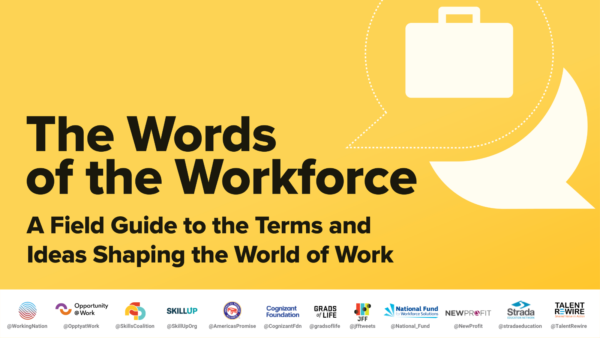Building a shared lexicon for a critical national conversation
 As the country continues to navigate the pandemic and its impact on the labor market, we are seeing an entrenched dynamic starting to shift. Workers and job seekers feel empowered to demand more from a job and from their employers, and business leaders are making renewed commitments their employees. We’re also looking at an enormous infusion of federal resources to engage employers and ensure workers have skills and good pathways to quality jobs. As my colleague Hollie Marston recently wrote, “Workforce is having a moment.”
As the country continues to navigate the pandemic and its impact on the labor market, we are seeing an entrenched dynamic starting to shift. Workers and job seekers feel empowered to demand more from a job and from their employers, and business leaders are making renewed commitments their employees. We’re also looking at an enormous infusion of federal resources to engage employers and ensure workers have skills and good pathways to quality jobs. As my colleague Hollie Marston recently wrote, “Workforce is having a moment.”
The seismic effects of the pandemic have generated increased attention on issues of workforce development, economic mobility, and opportunity — attention from politicians, from influencers, from the media. And as these issues saturate the national narrative, the muddiness and complexity of the terminology used to describe them is exposed. In the early days of the pandemic, we hailed essential workers as heroes. Who are “essential workers”? Is that a technical term? What do we actually mean when we say “skills gap”? When elected officials say that their policies will create “good jobs,” what does that mean?
Over the past few months, the National Fund has been working with experts across a diverse cross-section of workforce-related organizations to address this challenge. We’re excited to share the first draft of our new field guide, The Words of the Workforce.
The guide is the result of a collaborative effort by a diverse group of nonprofit workforce organizations. We’re grateful for the partnership of Opportunity@Work, Strada Education Network, Talent Rewire, Whiteboard Advisors, America’s Promise, Cognizant Foundation, Grads of Life, Jobs for the Future, National Skills Coalition, New Profit, and WorkingNation as this document has come together over the past few months.
I am a self-described word nerd and plain language advocate, and this initiative was right up my alley. Our work group started with the idea of a style guide, in the manner of the AP Stylebook’s subject matter sections for sports, law, food, etc. But a style guide felt too prescriptive. Indeed, the goal of what we are calling a “field guide” is not to prescribe definitions that will always apply in every case. Rather, it is to shed light on the way that core terms are (and are not) used by education and workforce experts, so that journalists, analysts, and advocates can move toward a shared lexicon for what is an increasingly critical issue in the national discourse.
We want this guide to kick off a conversation about how language shapes the policies, practices, and perceptions that define the world of work. This is particularly critical right now, because we cannot separate how we talk about work — and workers — without acknowledging the context of systemic racism and persistent, stark inequities. If we seek to build a more equitable, just society, we must critically examine the language we use – and the language we don’t.
It’s also worth noting that this is a living document — so we’re excited for your feedback! We look forward to continued conversation, input, and critiques that will improve the field guide and help us collectively think more deeply and actively about how the words we use can shape the world we build together.



